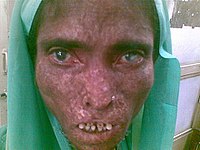
Photo from wikipedia
INTRODUCTION: Currently, there are no laboratory tests or sensitive and specific molecular markers for the early diagnosis of leprosy. The aim of this study was to analyze the clinical characteristics… Click to show full abstract
INTRODUCTION: Currently, there are no laboratory tests or sensitive and specific molecular markers for the early diagnosis of leprosy. The aim of this study was to analyze the clinical characteristics of patients with leprosy and investigate their immunological profile, comparing this with the type of lesion and the presence or absence of a Bacillus Calmette-Guérin (BCG) vaccination scar. METHODS: Statistical analyzes were performed by employing comparative tests (Pearson´s chi-square) to evaluate the variables in different clinical forms, considering significance at the 5% level. RESULTS: The study identified a predominance of lepromatous leprosy (26.9%) in patients aged between 34-53 years. Caucasians predominantly had borderline tuberculoid (BT) clinical forms (42%); a predominance of males with borderline lepromatous (19%) and lepromatous leprosy (26.9%) forms was observed; and the presence of BCG vaccination scars (27.5%) and lower limb nerves were more affected (38%) predominantly in the BT clinical form. Significant differences were identified, which included hypochromic lesions predominantly in the BT clinical form (24%); diffuse-type lesions predominantly in the tuberculoid (TT) clinical form (28%); ill-defined lesion border dominance in lepromatous leprosy (LL) clinical forms (30%); an irregular lesion limit predominantly in LL clinical forms (32%); and a predominant Th1 immune response in the BT clinical form (41.7%). CONCLUSIONS: The evaluation of the immunological profile in leprosy patients may contribute to the more detailed diagnosis and possibly better characterization of the prognosis for these individuals.
Journal Title: Revista da Sociedade Brasileira de Medicina Tropical
Year Published: 2017
Link to full text (if available)
Share on Social Media: Sign Up to like & get
recommendations!